ECOLOGICAL RESTORATION OF KEY SPECIES ON ESPAÑOLA ISLAND
Ecological restoration of Española Island through adaptive management for the recovery of the emblematic species Opuntia megasperma var. orientalis
Opuntia megasperma var. orientalis, hereinafter referred to only as "Opuntia", is a species of cactus endemic to Española island with important ecosystem services since it is a source of food for the endemic fauna of the island, such as the giant tortoises of Española (Chelonoidis hoodensis), is a nesting and feeding structure for birds, and is also a refuge for many other endemic and native species that inhabit the island. Unfortunately, Opuntia vegetation was drastically reduced by the presence of an invasion of feral goats for more than two centuries (Carrion et al., 2011). Although this invasive species was eradicated in 1978 (Calvopiña, 1978), Opuntia has not recovered from the damage suffered. Among the factors that hinder its recovery are:
- slow growth, of approximately 2 cm per year
- natural herbivory of endemic fauna, such as turtles, mockingbirds and finches
- low availability of water in the soil due to the arid climatic conditions of the island
Due to these reasons, this project seeks to contribute to the restoration of the ecological integrity of Española Island through the recovery of the Opuntia population using innovative and effective strategies.
The ecological restoration of Opuntia has been carried out through two phases: the first, started in June 2017, where the effectiveness of water-saving technologies was measured, and the second, in September 2022, where the adaptive management of Opuntia is being evaluated through the use of ecological restoration tools that allow the retention of water and nutrients in the soil.

Map of the population distribution of Opuntia megasperma var. orientalis during the first experiment where the effectiveness of water-saving technologies was measured.
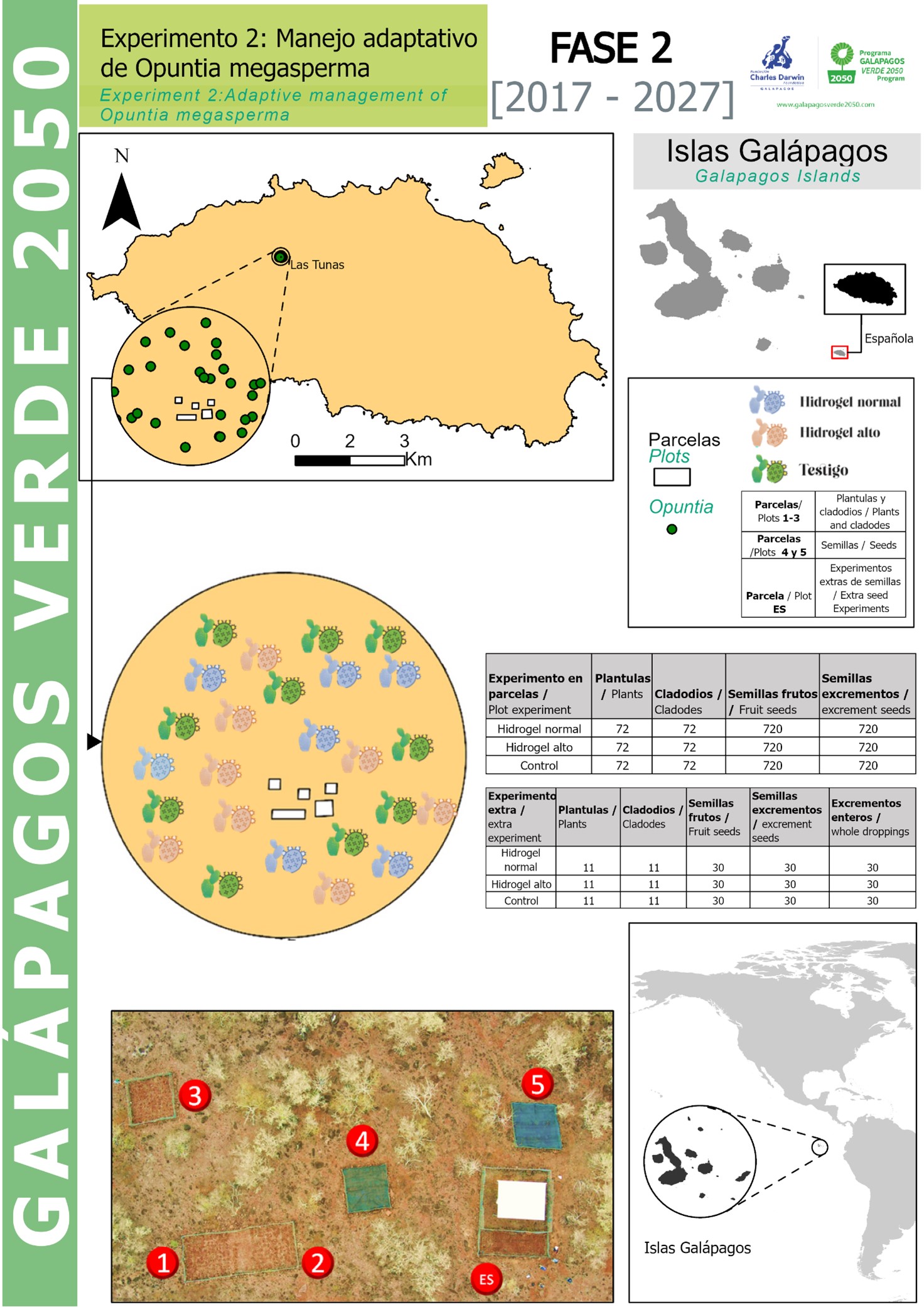
Map of experiments in permanent plots and additional experiments with cladodes, seedlings, seeds and pure excrements.
Timeline
The Green Galapagos 2050 (GV2050) was launched in 2013 as a single project with two components: ecological restoration and sustainable agriculture. Maintaining this structure until 2021, when it takes the category of Program made up of 7 different projects.
GV2050 has been divided into three different phases: the first includes the start of the Program in 2013 until July 2017; the second, which starts in July 2017 and will last until July 2027; and the third stage will begin in August 2027 and will last until the end of 2050.
In the period from 2013 to 2021, various experiments were carried out in the different study sites that are currently active, adding new sites each year. On the island of Española, it is not until June 2017, at the end of phase one, that Galapagos Verde 2050 begins to work for its conservation. The different phases programmed for this project are developed from here, which will end when the third phase finishes in 2050.

Ecological Restoration phases in Española.
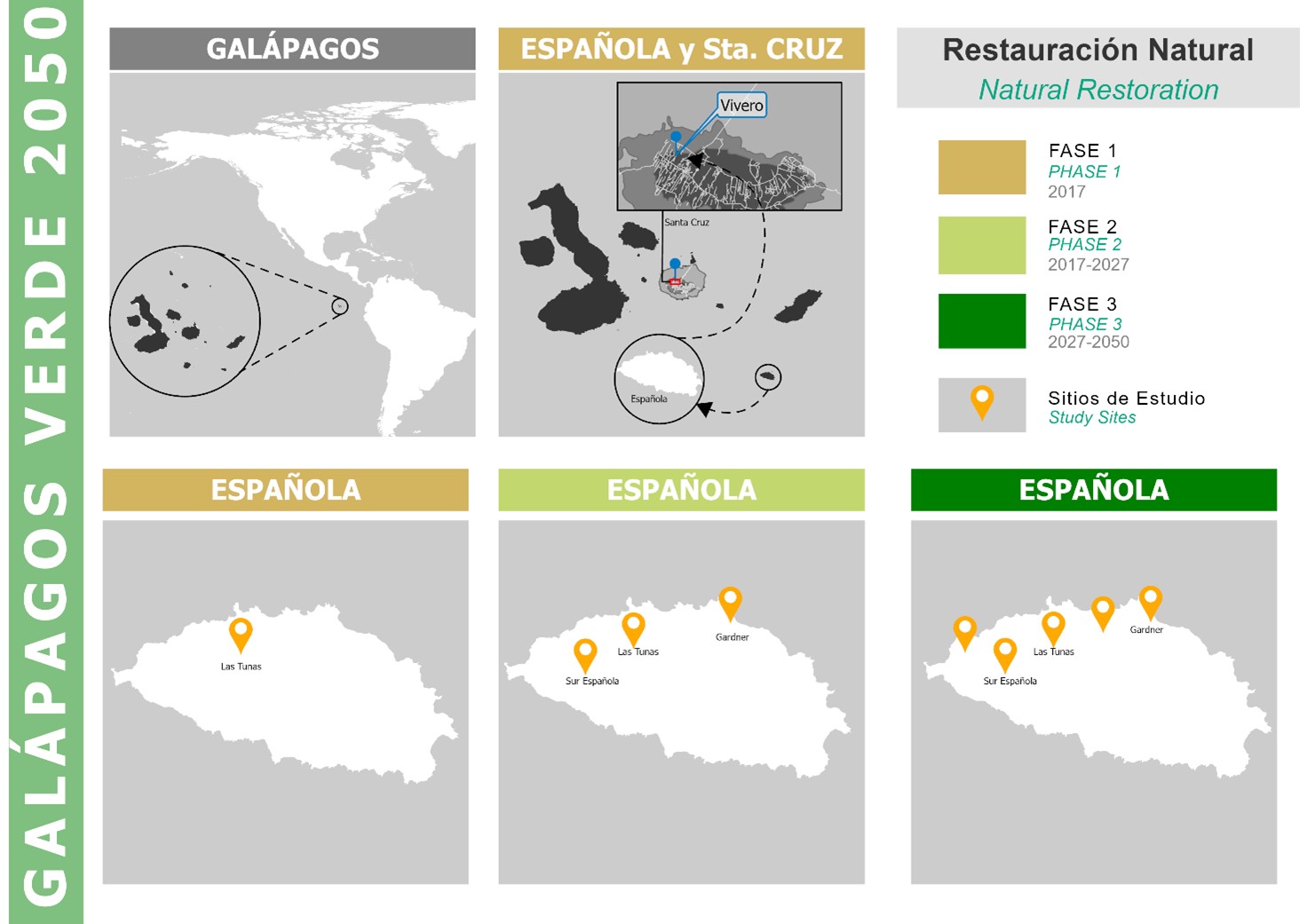
Phases and study sites of the ecological restoration project of the emblematic species Opuntia megasperma var. orientalis.
Obtained Results
During the first phase, ex-situ germination experiments were carried out with Opuntia seeds extracted from fruits, comparing Hydrogel with the control. Unfortunately, the germination rate was very low (5.4 and 4%, respectively).
In the second phase, in the period from 2017 to 2020, vegetative propagation or asexual reproduction experiments were conducted by planting cladodes in situ using water-saving technologies (Groasis Waterboxx®, Groasis Waterboxx® + Hydrogel) with a survival rate of (~75-80%) versus their respective controls (~40%). The result was successful, and with this, the GV2050 team has developed a method for the asexual reproduction of Opuntia (Jaramillo et al., 2020; Tapia et al., 2019). From this moment on, the priority is the vegetative propagation experiments in Las Tunas site. Once the restoration efficiency is increased, they will be expanded to the remaining areas.

Adult cactus (left) and collection of cladodes (right) for in situ propagation experiments on Española Island.
In the second phase, starting in September 2022, five new experimental plots have been implemented in Las Tunas to restore O. megasperma var. orientalis to obtain sufficient vegetative material to continue the propagation of the species on the island. Initially, the cladodes were planted in these permanent plots, and after a few years, those cladodes that have developed roots and have managed to grow should be moved to other fenced plots, thus being more protected from tortoises. As part of these experiments, the cladodes are planted with different ecological restoration tools to study which of all the technologies works best with this species on this island (Negoita et al., 2021).
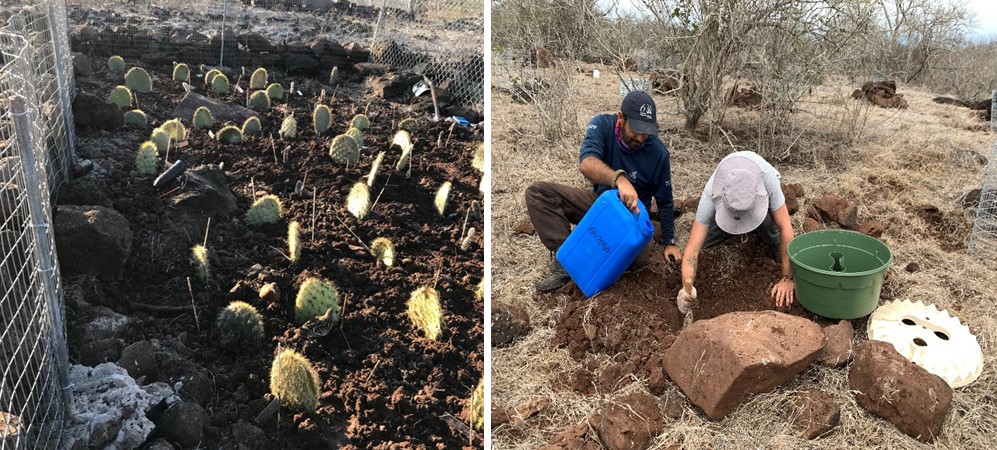
Can you imagine how many plants we have planted in Española?
Since 2017, in the town of Las Tunas on the island of Española, experiments have been conducted to test the effectiveness of water-saving technologies (Tapia et al. 2019), which taught us that the reality of each island is different and very particular. Even though the plants were protected with fences to avoid damage by animals, these protections were not very effective, for which new strategies were proposed allowing adaptive management through the construction of permanent plots to reinforce the protection of the cacti that would be planted once its construction was finished. In situ experiments began in September 2022 to evaluate the local adaptation of 4-year-old repatriated strengthened seedlings versus fresh cladodes obtained in the field, subjected to ecological restoration tools that allow water and nutrient retention. In parallel, in situ germination trials were established with seeds obtained from fruits and droppings, which were subjected to the same treatments used in seedlings and cladodes.
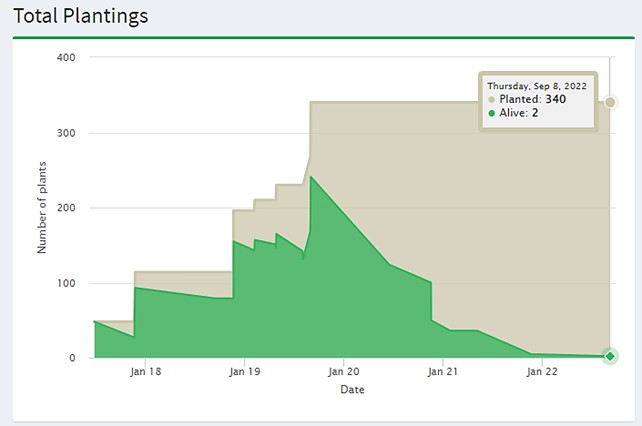
Representative graph of all O. megasperma in Española. All the sown plants are grey, and the living species are green. Source: RestoR GV2050. Capture date: October 2022.
The following graph shows the predictions expected for water-saving technologies, with the Waterboxx® treatment presenting the highest expected survival percentage, followed by the Hydrogel treatment, with 85 and 80%, respectively. Both treatments present a considerable error bar, so despite presenting the highest %, they are not the most effective treatments. On the other hand, there is the combination of Hydrogel + Waterboxx® treatments, which, despite presenting a lower % expected survival (75%), could be said to be the most effective treatment because it has the lowest error bar. , in a range of values similar to the previous treatments.
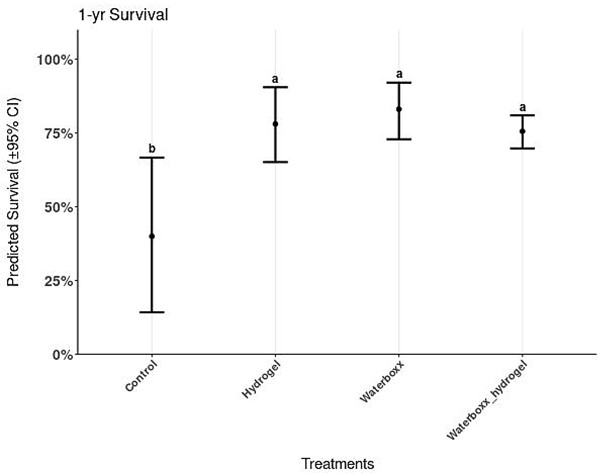
Representative graph of the expected survival percentage according to the applied water-saving technology. Source: RestoR GV2050. Capture date: October 2022.
Some of our expeditions...
Did you know that with the restoration of O. megasperma in GV2050 and contributing to recovering the ecosystem, we are helping to conserve the population of giant tortoises on Española Island?
In 2022, the GV2050 team, together with park rangers from the Galapagos National Park Directorate (DPNG), undertook an expedition to the island to start new experiments that would allow the recovery of the only species of Opuntia present on the island, using tools that help to ecological restoration, essential in such a hostile environment.
In the greenhouse of the DPNG on Santa Cruz Island, we obtained seedlings of Opuntia megasperma var. orientalis at four years of age from seeds extracted from the droppings of giant tortoises.
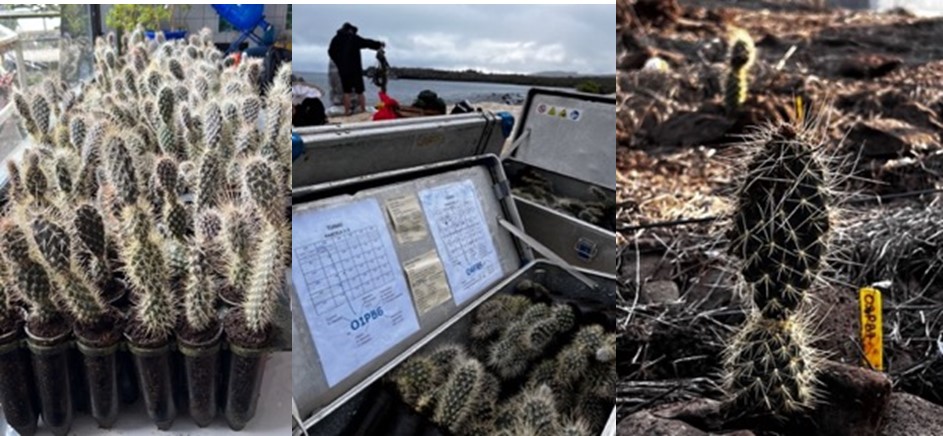
Fortified seedlings from the Hernán Carrión greenhouse of the DPNG at four years of age.
These plants were rigorously inspected by the Agency for Regulation and Control of Biosafety and Quarantine for Galapagos (ABG) to ensure that they are clean, without pests or diseases, and subjected to quarantine together with materials, equipment and luggage of the GV2050 staff and park rangers.
Once in Las Tunas, eight different experiments were carried out, the most notable being the direct sowing of cladodes, direct sowing of reinforced seedlings, and direct sowing of seeds extracted from Chelonoidis hoodensis excrement and fruits.
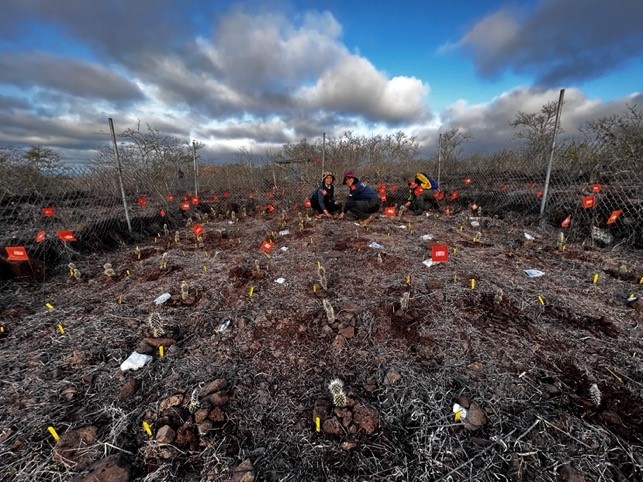
GV2050 team planting in the fenced plots in Las Tunas.
The objective of GV2050 is to determine the best ecological restoration technology for the local adaptation of the 250 repatriated seedlings and the 4,500 seeds sown in the five permanent fences: Afterwards, we will use the best technology to conduct large-scale restoration efforts.
Do you want to know more about our project in Española Island?
- Ecological restoration on Española Island
-
Life re-emerging! Galápagos Verde 2050: Cacti recovering on remote islands
-
Tortoises are not the only ones returning to Española Island (Galapagos Verde 2050)
-
Galapagos Verde 2050 is Starting the Process of Ecological Restoration on Española Island
You can also find our news on social networks:
- Facebook post about a trip to Española
- Facebook post about Opuntia megasperma var. orientalis at Española
- Facebook post about trip to Española in 2020
- Facebook post about GV2050 restoration efforts in Española
You can download more information about some of our publications:
Download the book "Galapagos Verde 2050 (Volume 1)"
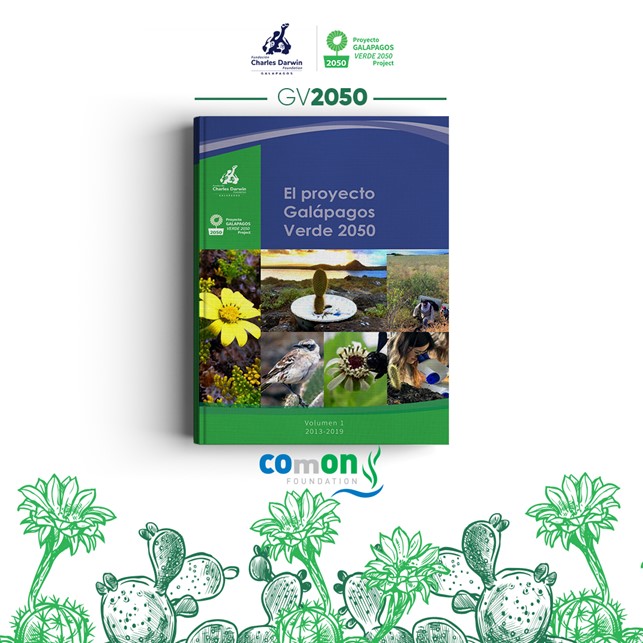
Download triptych leaflet about the work of the GV2050

Download scientific article on the effectiveness of water-saving technologies
Download scientific article on the cost-effectiveness of water-saving technologies
REFERENCES
Calvopiña, L. (1978). Racal Radios in the Campaign of Feral Goat Eradication From Española Island. Archivos del PNG.
Carrion, V., Donlan, C. J., Campbell, K. J., Lavoie, C., & Cruz, F. (2011). Archipelago-Wide Island Restoration in the Galapagos Islands: Reducing Costs of Invasive Mammal Eradication Programs and Reinvasion Risk. PLOS ONE, 6(5), e18835. https://doi.org/10.1371/JOURNAL.PONE.0018835
Jaramillo, P., Tapia, W., Negoita, L., Plunkett, E., Guerrero, M., Mayorga, P., & Gibbs, J. P. (2020). El Proyecto Galápagos Verde 2050.
Negoita, L., Gibbs, J. P., & Jaramillo Díaz, P. (2021). Cost-effectiveness of water-saving technologies for restoration of tropical dry forest: a case study from the Galapagos Islands, Ecuador. Restoration Ecology, 30(5). https://doi.org/10.1111/rec.13576
Tapia, P. I., Negoita, L., Gibbs, J. P., & Jaramillo, P. (2019). Effectiveness of water-saving technologies during early stages of restoration of endemic Opuntia cacti in the Galápagos Islands, Ecuador. PeerJ, 2019(12). https://doi.org/10.7717/peerj.8156
Interinstitutional collaborations
Galapagos National Park Directorate (PNGD), Galapagos Conservancy, Agency for the Regulation and Control of Biosafety and Quarantine for Galapagos (ABG).
Our main donor
COmON Foundation

 Donors:
Donors:

Partners:




